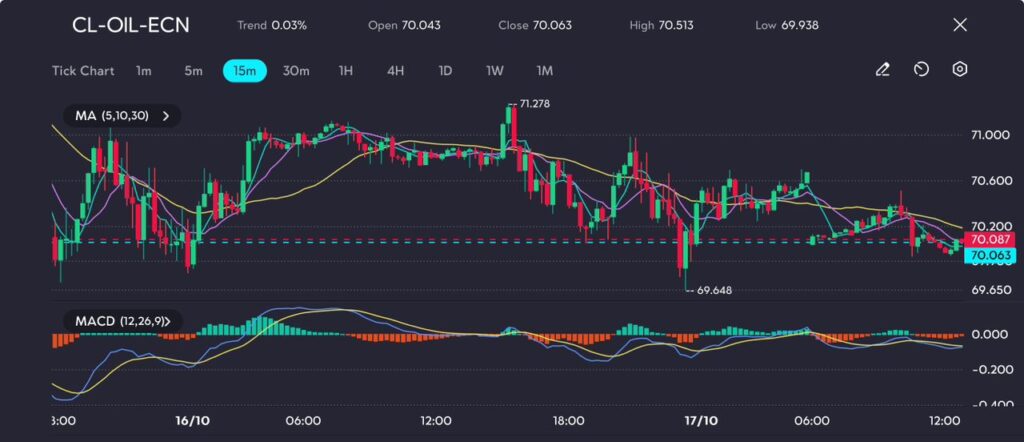Key points:
- Brent crude futures rose 0.2%, reaching $74.39 per barrel, while WTI crude increased by 0.3%, hitting $70.58.
- Oil prices are down by about 6-7% this week after OPEC and IEA cut demand forecasts for the coming years.
Oil prices saw a slight increase after hitting two-week lows earlier in the week.
Brent crude gained 17 cents, or 0.2%, reaching $74.39 per barrel, while U.S. West Texas Intermediate rose by 19 cents, or 0.3%, to $70.58.
This uptick reflects market participants awaiting developments in the Middle East and fresh details on China’s stimulus efforts.
Both benchmarks had settled lower for two consecutive days, reaching their weakest levels since October 2.
Tensions Linger Despite Spike
The market continues to be under pressure this week, with a decline of around 6-7%, driven by reduced demand forecasts from OPEC and the International Energy Agency (IEA) for 2024 and 2025.
Traders are closely watching for further reactions from Israel in response to recent tensions with Iran. Meanwhile, official U.S. oil inventory data, expected later today, could further influence market direction, particularly if it reveals weak demand.

Picture: Crude oil consolidates at 70.063, with bearish momentum building, as seen on the VT Markets app.
Crude oil closed at 70.063, with the session moving between 69.938 and 70.513. What we’re seeing here is an indication of consolidation just below the resistance level of 71.278, with some recent downward pressure evident.
Moving averages (5, 10, and 30 periods) are tightly grouped, pointing to indecision in the market.
The MACD suggests a bearish crossover as the MACD line dips below the signal line, with the histogram reflecting increasing negative momentum.
This indicates selling pressure could continue in the near term.
Israel-Hamas Conflict Intensifies
This week’s decline has been influenced by easing concerns about an oil supply disruption linked to the ongoing Israel-Hamas conflict.
Although some analysts believe retaliation from Israel against Iran is inevitable, the timing remains unclear, which has tempered risk premiums on crude prices.
While the oil spill off Iran’s Kharg Island grabbed attention, it appears unrelated to current tensions, according to analysts at ANZ.
Eyes on China
Attention has also shifted to China, where more clarity on fiscal stimulus plans is expected.
China’s announcement to expand financing for housing projects and increase bank lending to 4 trillion yuan, or $562 billion, suggests measures to revive its property sector, a key driver of its economy.
Any moves that bolster China’s economic outlook could provide support for oil demand, as China remains one of the largest oil consumers globally.
Dip in U.S. Oil Market
In the U.S., oil market participants were surprised by an unexpected drawdown in crude and fuel stocks.
The American Petroleum Institute reported that crude oil inventories fell by 1.58 million barrels last week, while gasoline and distillate stocks dropped by 5.93 million and 2.67 million barrels, respectively.
This contrasts with earlier estimates of a 1.8 million barrel build, raising expectations ahead of the official Energy Information Administration report due today.
Any signs of weakening demand from the EIA’s report could exert additional downward pressure on prices, particularly as traders remain cautious following the recent revisions to future oil demand by OPEC and the IEA.
In contrast, continued tightness in U.S. fuel inventories could provide short-term support, limiting further price declines.
What’s Next: ECB
Looking ahead, today’s European Central Bank meeting will be closely watched, as it may signal a shift towards economic growth protection rather than solely focusing on inflation control.
If the ECB cuts rates as expected, this could support economic activity in the euro zone, potentially improving demand for energy.
However, we remain cautious in our outlook, with oil prices likely to remain under pressure in the near term until more definitive factors emerge regarding global demand and geopolitical risks.
Start trading now — click here to create your live VT Markets account.









